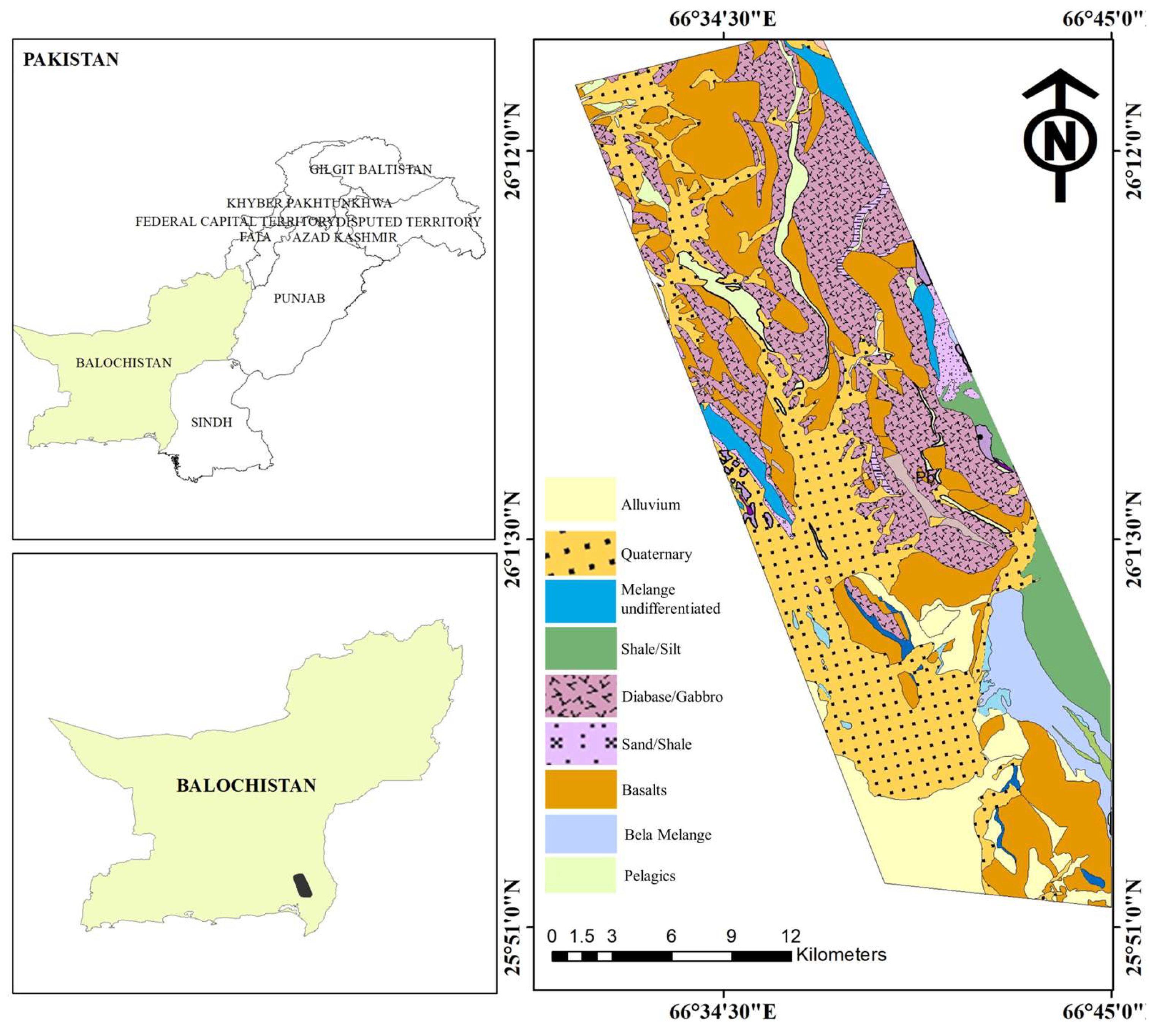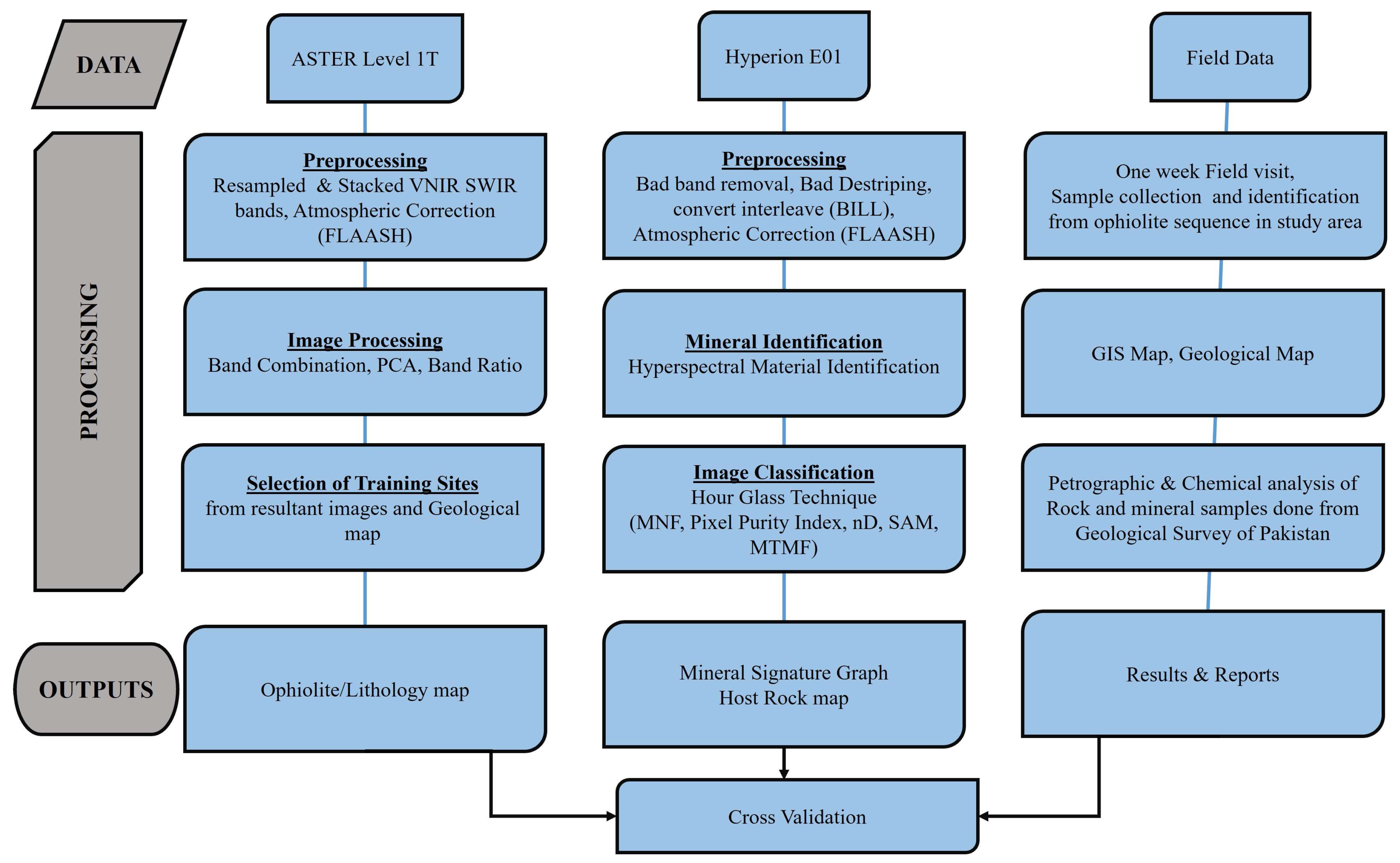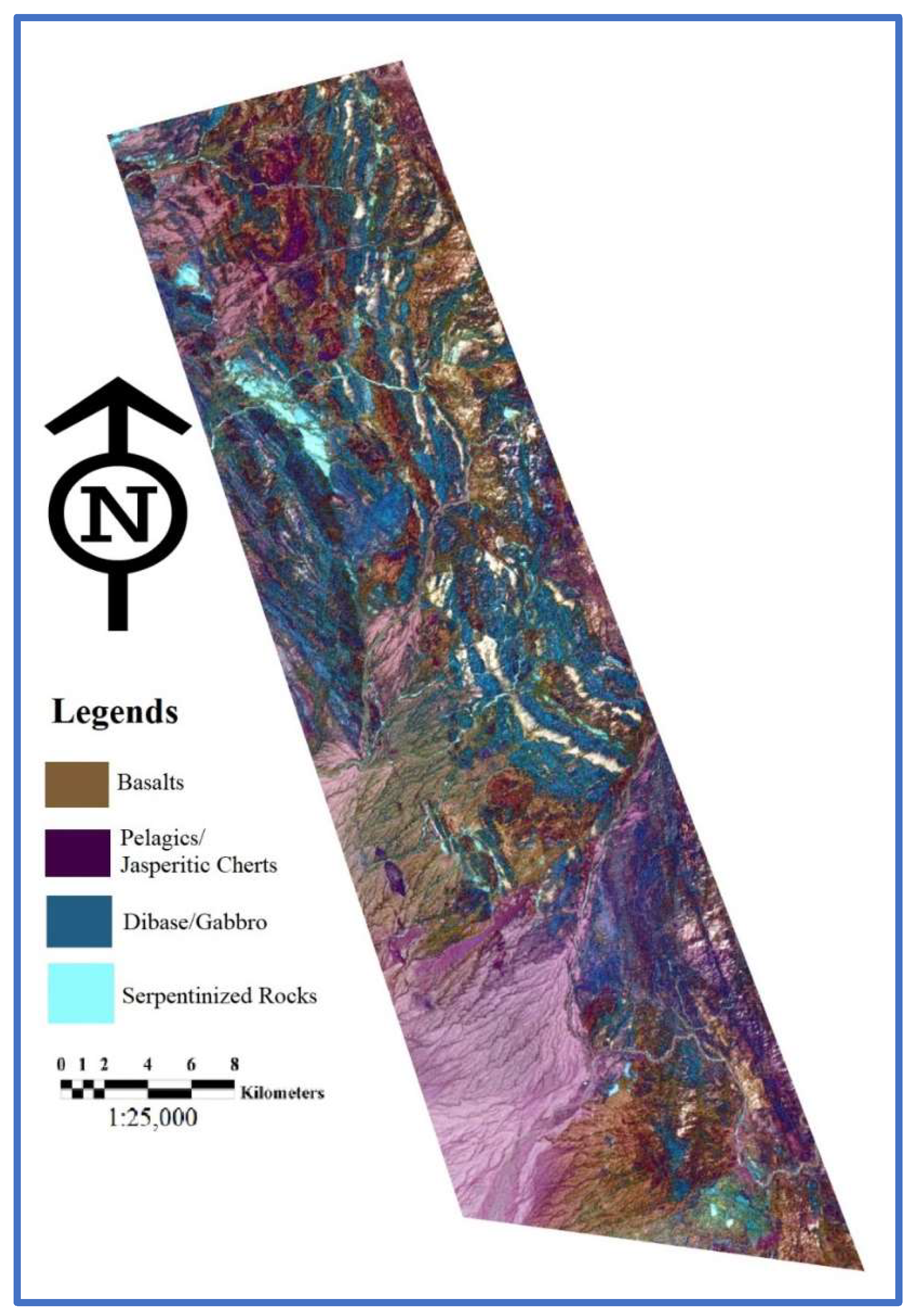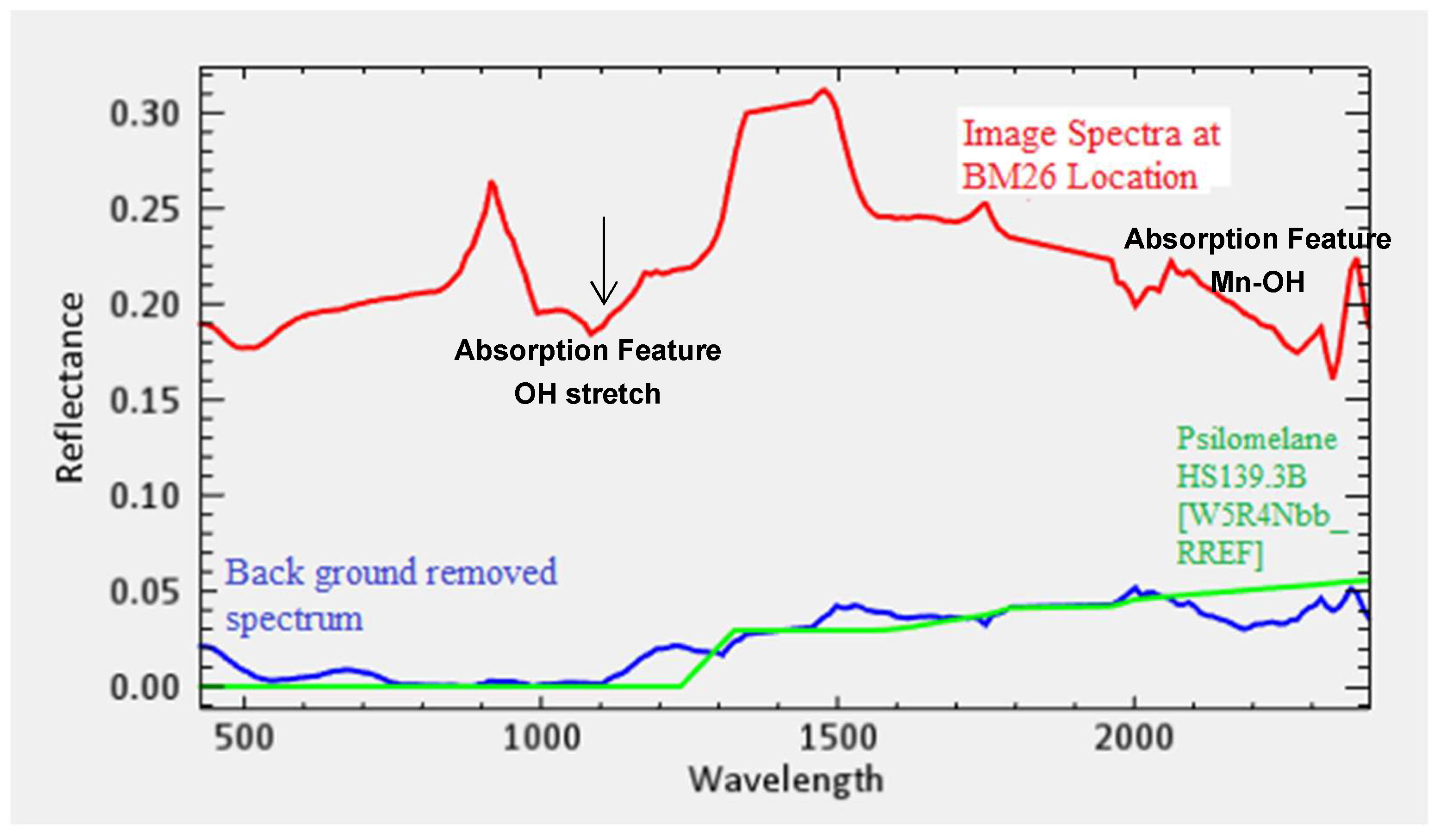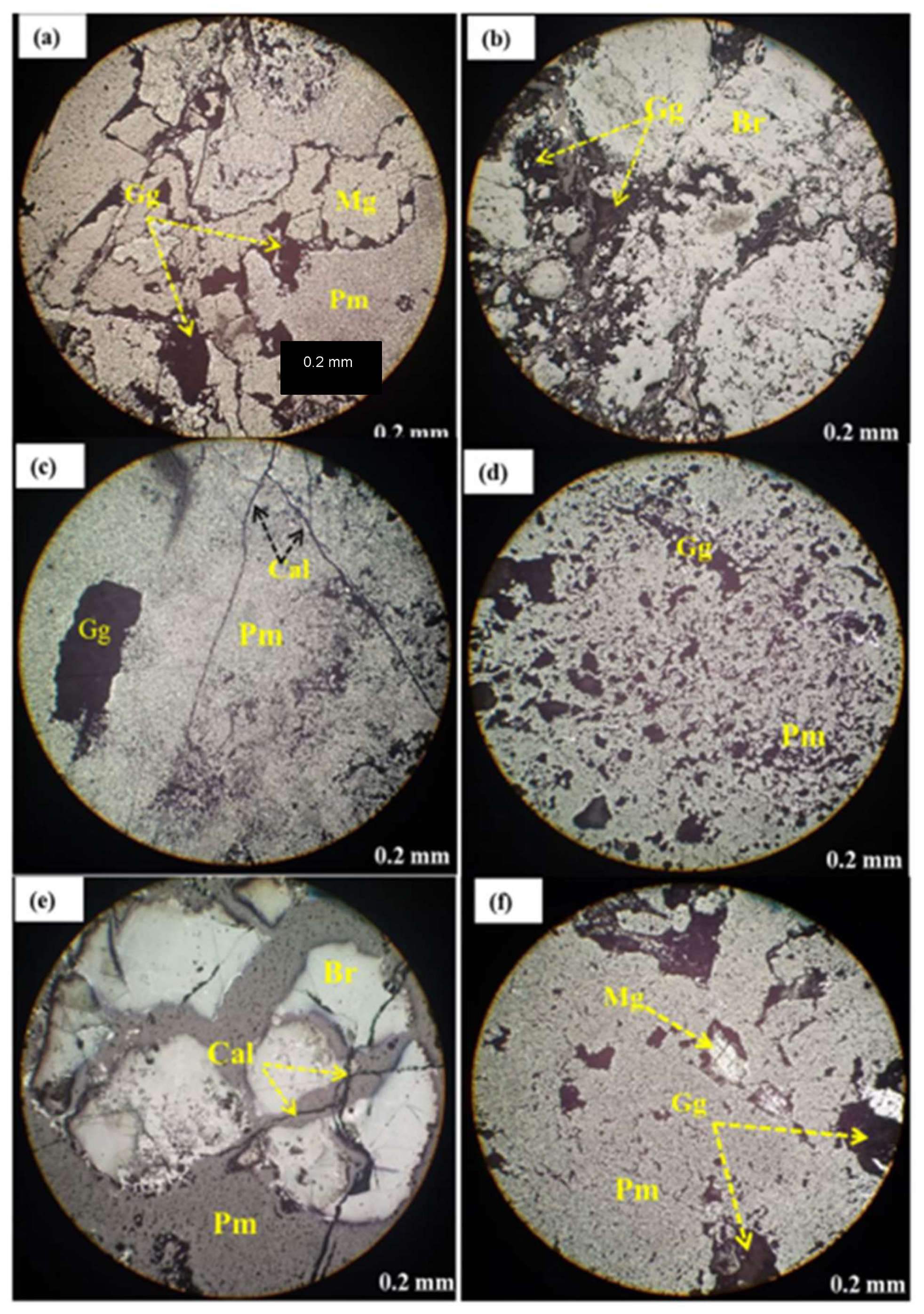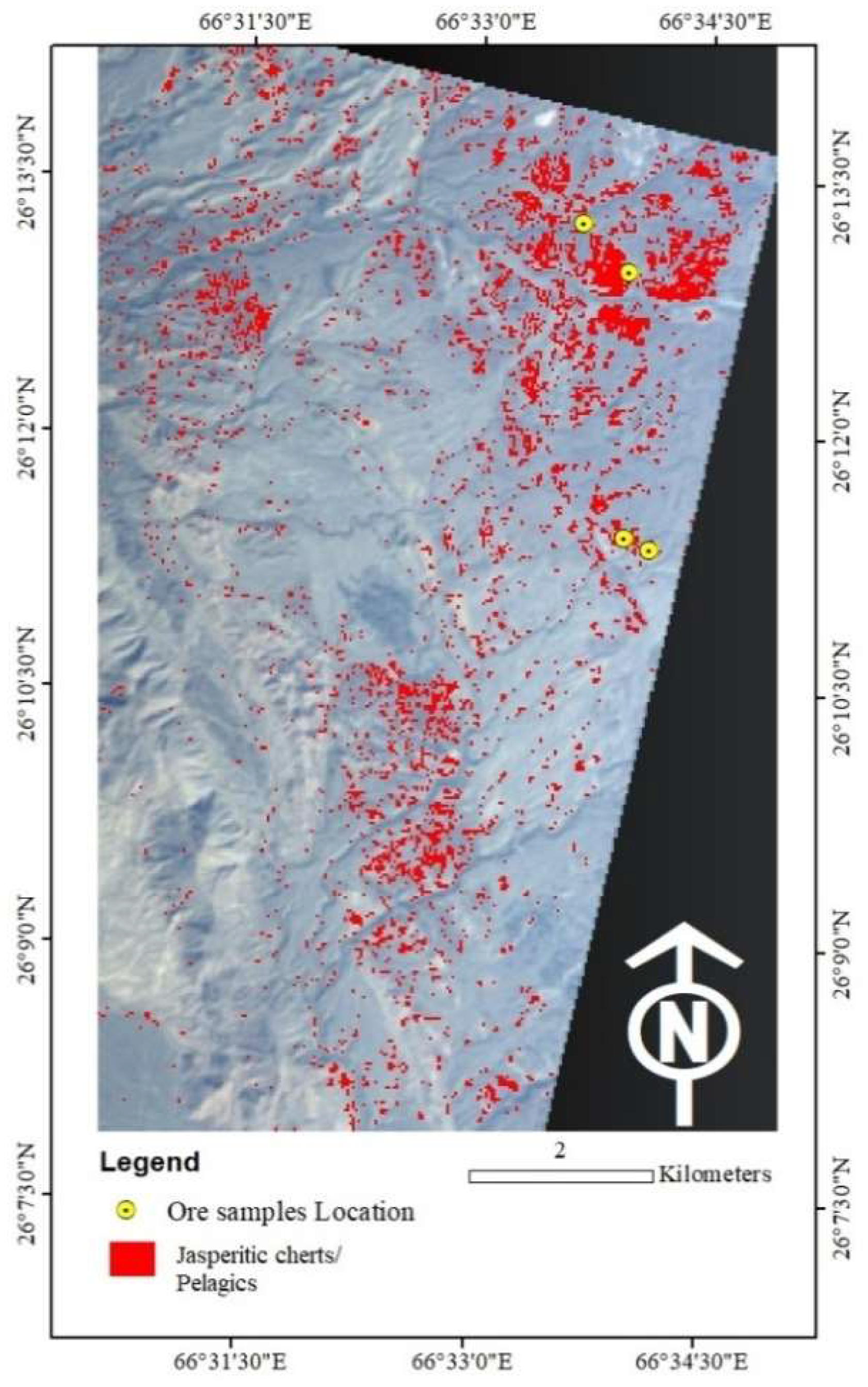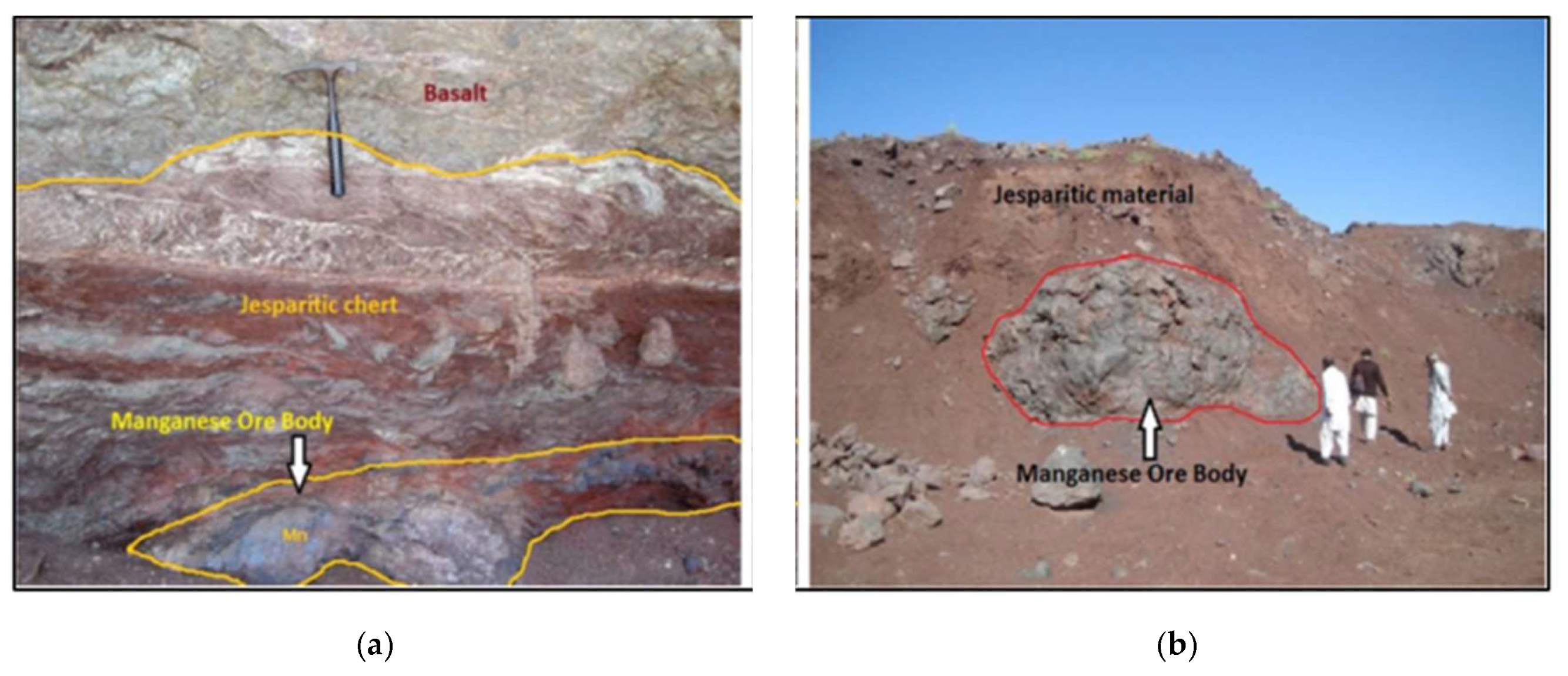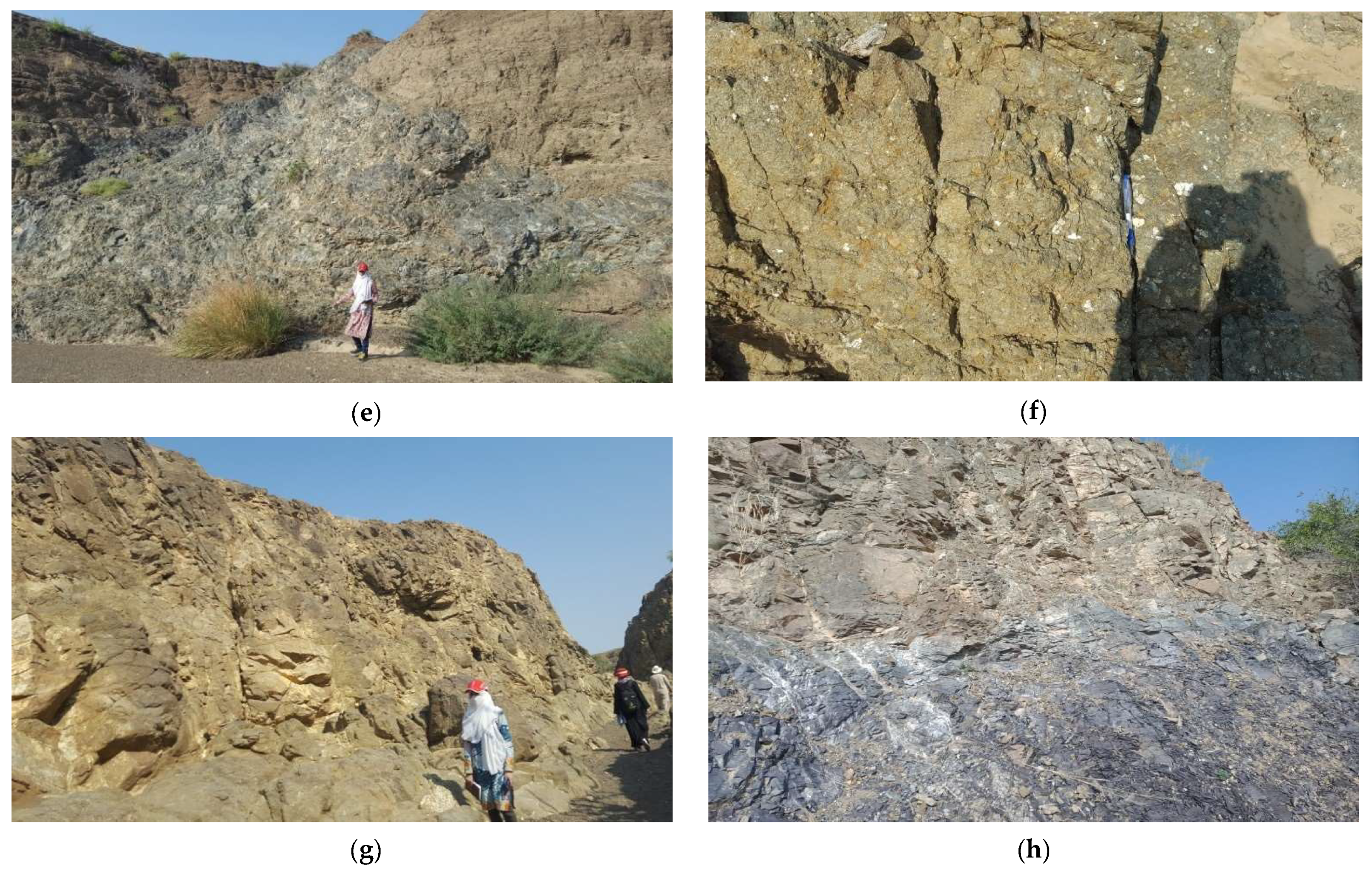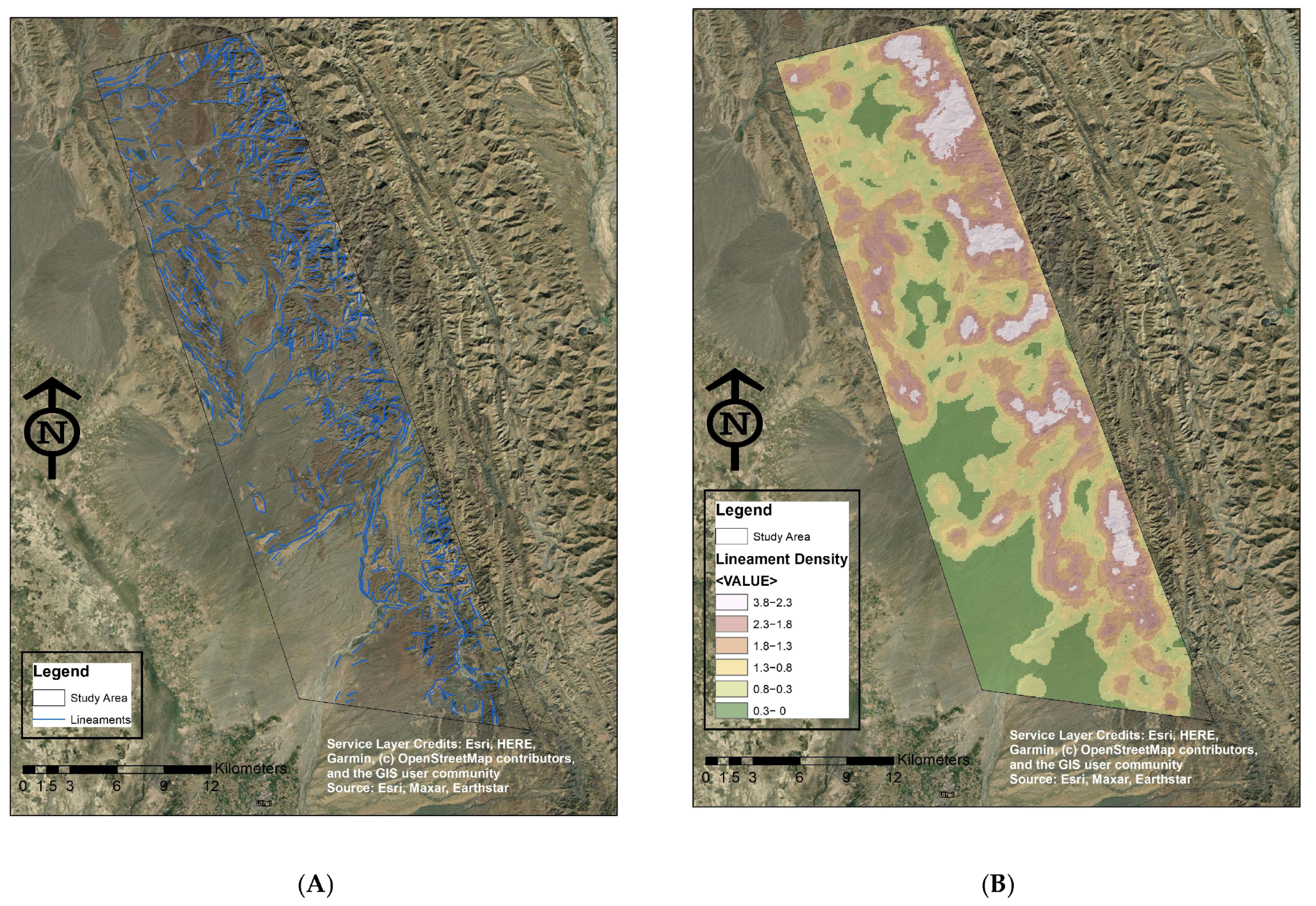1. Introduction
In Pakistan, ophiolitic sequences formed along the Neotethys ocean floor before the Late Cretaceous collision between the Indian and Eurasian plates. These sequences are observed across various regions, from the Karakorum–Himalaya to the Lasbela District [
1,
2]. While the northern belts have been extensively studied, the southwestern margin, specifically the Bela Ophiolitic Complex (BOC), remains relatively underexplored [
3]. The BOC, located along the Indian–Asian boundary, is the largest ophiolitic belt in Pakistan, extending over 450 km in length and approximately 10 km in width, much of which is obscured by alluvial cover [
4]. The BOC consists of serpentinized mantle harzburgite, layered peridotite, gabbros, sheeted dykes, basaltic pillow lavas, and sedimentary rocks [
5]. Its economic significance is demonstrated by the occurrence of metals such as Fe, Mn, Ti, Cr, Ni, Co, Zn, and Pb. The mafic and ultramafic sequences, in particular, are prime targets for metallogenic studies [
6,
7].
Hydrothermal manganese deposits of volcanogenic sedimentary origin have been proposed within this complex, supported by magnetic signatures and aeromagnetic anomalies [
8], which collectively reinforce the BOC’s mineralization potential. Ref. [
9] further substantiated this by integrating magnetic, geophysical, and geochemical analyses to identify enrichment zones for Mn, Fe, Zn, and Cu, advocating a multidisciplinary approach for subsurface mineral exploration. In the region northwest of Karachi, the Bela Ophiolites comprise a variety of rock types, including serpentinized ultramafics, peridotite, dunite, basalt, gabbro, pelagics, and carbonate formations. Understanding these ophiolite complexes offers insights into the processes of crustal accretion and oceanic lithosphere evolution [
10,
11]. The underlying metamorphic rocks, located beneath harzburgite layers, often exhibit reverse metamorphism, indicative of tectonic uplift and crustal replacement mechanisms [
12].
The prevalence of traditional field-based techniques in Pakistan has presented logistical and financial obstacles for ophiolite mapping, especially in challenging landscapes. Satellite-based techniques have increasingly been used for chromite and manganese exploration [
13,
14]. The use of satellite data for lithological mapping and mineral exploration is expanding [
15,
16]. Hyperspectral and multispectral sensors are particularly effective in identifying minerals based on spectral signatures [
17].
The launch of NASA’s ASTER sensor revolutionized geological investigations by enabling regional lithological mapping of ophiolitic terrains [
18,
19,
20]. With its 14 spectral bands, ASTER is capable of detecting key minerals through its SWIR bands, which are sensitive to Al-OH, Fe, Mg-OH, Si-O-H, and CO
3 features [
21,
22]. ASTER has been effectively applied to ophiolite-related chromite exploration in various regions [
23,
24,
25]. Hyperion hyperspectral imagery, with its high spectral resolution and 242 bands, is well suited for detecting subtle lithological variations and hydrothermal alteration minerals [
26,
27]. It has been used in combination with image classification methods such as band ratios, Minimum Noise Fraction (MNF), Feature-Oriented Principal Components (FOPCs), Maximum Likelihood Classifier (MLC), Spectral Angle Mapper (SAM), Matched Filtering (MF), and Linear Spectral Classification (LSC) [
28].
Despite these advancements, the Bela Ophiolitic Complex remains inadequately mapped using ASTER and Hyperion data, especially with respect to manganese mineralization. Remote sensing offers a promising and efficient alternative for exploration in this remote and geologically intricate region. This research aims to map lithological units and manganese mineralization zones in the Bela Ophiolite (BO) region, specifically near Uthal and Bela Tehsils. This study integrates field-based rock sampling with ASTER and Hyperion satellite data to establish reference spectral signatures. Advanced image processing techniques, including band ratio (BR), False Color Composites (FCCs), Principal Components (PCs), Optimum Index Factor (OIF), and Spectral Angle Mapper (SAM), are applied to discriminate lithological units and mineralization zones.
2. Geology of the Study Area
Lasbela District, located in southwestern Pakistan, lies along the western margin of the Indo-Pakistan continental plate. This region hosts a significant segment of the ophiolitic belt that developed on the Neotethys oceanic crust prior to its collision with the Eurasian plate during the Late Cretaceous [
1]. The Bela Ophiolite Zone (BOZ) within Lasbela is surrounded by a complex framework of tectonic and lithological units, reflecting its position in an active orogenic setting [
29]. To the north, the Khuzdar “knot” comprises Mesozoic rocks with distinctively deformed and folded structures [
30], beyond which lie the Kalat Plateau, Quetta Syntaxis, Muslimbagh Ophiolites, and the major Chaman Fault. The Khuzdar knot and Quetta Syntaxis show a prominent east–west arcuate structural pattern that sharply contrasts with the dominant north–south alignment of the axial fold–thrust belt [
31,
32,
33].
To the east of the BOZ are the Mor, Pab, and Kirthar mountain ranges. The contact zone between the ophiolites and adjacent sedimentary formations is tectonically defined and marked by a 25 m wide crush zone comprising sheared shales, gabbros, diabases, and calcareous slates [
1]. The stratigraphy of the Bela Ophiolite exhibits a classical ophiolitic sequence, progressing from ultramafic rocks—such as lherzolite, harzburgite, and dunite—to layered gabbros, sheeted dykes, pillow basalts, and associated deep-marine sediments [
14,
34]. Manganese mineralization in the region is believed to have originated through the interaction of basaltic oceanic crust with seawater and hydrothermal fluids, possibly aided by mantle-derived volatiles. This has led to the formation of Mn-bearing minerals in jasperitic cherts and associated pelagic sediments [
35,
36]. The Bela Ophiolite Complex holds geological significance not only due to its well-preserved sequence (
Figure 1) and mineral potential but also as part of the larger Tethyan ophiolite belt, which extends across Iran, Afghanistan, and Oman. Despite its scale and economic promise, this segment of the ophiolitic belt remains underexplored in terms of detailed lithological mapping, particularly through advanced remote sensing techniques.
5. Discussion
This study highlights the strong potential of ASTER and Hyperion satellite datasets for lithological mapping and the detection of chromite-associated manganese mineralization in the ophiolitic complex of Lasbela, Balochistan. ASTER multispectral data, particularly through combinations such as bands 3, 6, 7 and 3, 7, 9 identified through high Optimum Index Factor (OIF) values, enabled clear spectral separation of lithologies, including serpentinized ultramafics, diabase, basalt, and gabbro. Notably, these techniques facilitated the detection of lithological units that may have been underrepresented in earlier geological surveys, suggesting previously unmapped compositional diversity in the study area. PCA further enhanced boundary delineation and helped highlight subtle fault structures, often obscured by the region’s rugged topography.
This methodological framework builds on an established foundation of remote sensing applications in geological mapping. Prior work has demonstrated the efficacy of band ratio techniques [
54,
68,
69,
70,
71,
72,
73,
74] and false color composites [
74] in mapping ophiolitic terrains. Specific band ratios such as 4/7, 4/6, 4/10 [
69]; 4/1, 2/3, 4/3 [
54]; and 5/7, 5/4, 3/1 [
75] have proven successful in distinguishing ultramafic rock types. Composite indices like (2 + 4)/3 and (7 + 9)/8 [
56] also offer enhanced discrimination. In the present study, combinations such as (4/1, 4/5, 4/7), (5/3, 5/1, 7/5), and (4/7, 4/1, 4/3) were found to be well suited to the spectral characteristics of the Lasbela Ophiolite.
To support and validate the ASTER-based lithological interpretations, petrographic analysis was performed on representative rock samples, including diabase gabbro, ultramafic units, and pillow basalts. The primary objective was to confirm mineralogical composition and assess the degree of alteration and serpentinization within ultramafic rocks. Thin-section analyses were conducted under polarized light microscopy. In diabase gabbro samples, textures such as ophitic to sub-ophitic intergrowths of pyroxenes and plagioclase were observed, along with accessory opaque minerals including magnetite and ilmenite. The ultramafic samples revealed evidence of serpentinization, including characteristic mesh and bastite textures, suggesting alteration of olivine and orthopyroxene, respectively. Dominant secondary minerals such as antigorite were identified, with occasional relics of primary phases. Pillow basalts were found to be fine-grained and altered, with plagioclase laths and clinopyroxenes variably affected by uralitization. These petrographic observations were consistent with the lithological units interpreted from ASTER-based image processing, particularly in differentiating altered ultramafics from other mafic rocks. The petrographic data thus provided a critical line of validation, aligning with the spectral classifications and confirming the presence and alteration state of the major rock types mapped through remote sensing.
Hyperion’s hyperspectral capabilities, especially when processed using Hyperspectral Material Identification (HMI) tools and SAM classification, proved highly effective in recognizing manganese-bearing minerals. The implementation of advanced image processing techniques, including band combinations and SAM, allowed for effective discrimination of mafic and ultramafic lithologies, identification of structural trends, and detection of manganese-rich zones, particularly those characterized by psilomelane occurrences.
Field validation further confirmed the presence of psilomelane, braunite, and jasperitic chert. The consistent association of jasperitic chert with manganese suggests a genetic link to hydrothermal mineralization, aligning with patterns observed in other ophiolitic environments. From a mineralogical perspective, the observed transformation of braunite to psilomelane supports a hydrothermal paragenetic sequence, indicative of evolving geochemical and thermal conditions. Combining geochemical and spectral data to trace these transformations may enable differentiation between hydrothermal and supergene manganese phases, offering more refined mineral resource assessments.
These results are consistent with multiple regional and international case studies [
23,
24,
25,
72,
76,
77,
78,
79], reaffirming the utility of ASTER data for mapping lithologies associated with chromite and platinum group element (PGE) mineralization. This underscores the broader applicability of the approach for underexplored ophiolitic zones, such as those in Balochistan.
While the integration of remote sensing and field validation has yielded promising results, future enhancements could be achieved by incorporating high-resolution structural data into the analysis. Techniques demonstrated [
79,
80,
81] suggest that Digital Elevation Models (DEMs), such as those from ALOS PALSAR, could be used. The lineament and lineament density maps of the study area are shown in
Figure 14. Our method could significantly refine the interpretation of lineaments and structurally controlled mineralization patterns. Given the tectonic complexity of ophiolitic terrains, this enhancement would aid in identifying fault-associated mineral deposits with higher confidence.
Another promising direction involves applying an Analytic Hierarchy Process (AHP)-based mineral potential modeling framework. AHP integrates spectral, lithological, structural, and ground-truth data in a systematic spatial decision-making process. Its successful application in chromite exploration suggests it may also be valuable for manganese mineral targeting in similar geological environments.
As manganese grows in strategic importance, particularly for battery technologies and clean energy applications, understanding its mineralization in the Bela Ophiolite Complex holds both scientific and economic relevance. The integrated remote sensing and ground validation approach presented here offers a robust and cost-effective model for mineral exploration in challenging and geologically diverse terrains.
Overall, the combined use of ASTER and Hyperion data, advanced image processing, and field validation demonstrates a comprehensive framework for lithological and mineral mapping in ophiolitic contexts. While ASTER data provided the regional lithological context due to its spatial resolution, Hyperion data offered valuable mineral-specific insights, especially for manganese-bearing minerals like psilomelane and braunite. Hyperion’s high spectral resolution enabled detection of subtle mineralogical differences that ASTER could not capture, thus providing complementary value. Incorporating high-resolution structural datasets and decision support systems like AHP can further strengthen predictive models and reduce exploration uncertainty. This flexible and scalable methodology holds significant promise for deployment across the broader Tethyan orogenic belt and other underexplored metallogenic provinces worldwide.
